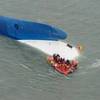Yellow line: Northwest Passage.
Blue line: Northern Sea Route
The International Ice Charting Working Group (IICWG), meeting at ESRIN in Frascati, issued the following statement on October 26, 2007: “In September 2007, the Arctic sea ice reached the minimum extent in the history of ice charting based on satellite, aircraft and surface observations, continuing a recent trend of diminishing sea ice that began in the 1980’s and has accelerated. While there will still be natural inter-annual variability, the decline is likely to continue.
“The Arctic is already experiencing an increase in shipping, primarily for oil and gas development and tourism, and we can expect to see further increases as diminishing ice extent makes Arctic marine transportation more viable. The IICWG members are working with national and international authorities to help ensure that Arctic navigation develops with the utmost regard for the safety of people, property and the environment.
“The IICWG cautions that sea ice and icebergs will continue to present significant hazards to navigation for the foreseeable future. The Arctic will still have a winter ice cover that will linger into summer for varying lengths of time depending on a range of conditions.”
Highlights for summer 2007:
• The minimum Arctic ice extent of 4.1 million square km was reached on September 16. This shattered the previous record low of 5.3 million sq. km. in 2005. The long term average minimum is 6.7 million sq. km.
• The area covered by ice within this extent is also at an all-time low, reflecting a thinner, weaker ice pack.
• The major ice retreat was away from the Siberian Arctic coastline towards Canada and Greenland, although the Taymyr ice massif persisted throughout the summer in the Laptev 2007 Envisat Mosaic of Arctic Ocean.
With the exception of this short but critical area, the Northern Sea Route was completely ice free from
August 22 until mid-October.
• This is the second year in a row that sea ice conditions in the Canadian Arctic have been extremely light and navigation in the Northwest Passage has been virtually unhindered by sea ice from the middle of August until well into October.
• This year’s reduction in sea ice extent has been much larger than expected. Given recent trends in the reduction in summer sea ice extent, the 2007 extent would not have been expected for decades.
• However, increased export of sea ice from the Arctic Ocean caused a return to near-normal conditions around Greenland after several years of low ice concentrations. Sea ice also reached the coast of Iceland, an infrequent occurrence.
• A decrease in Arctic sea ice is consistent with what scientists expect as a result of global climate change.
For more information on the IICWG, see http://nsidc.org/noaa/iicwg/.
Sponsored Content
Chris-Marine’s solutions help to prolong engine lifetime

AST is now AST Networks, bringing you remote connectivity wherever you are

March 2024
 Read the Magazine
Read the Magazine

 Read the Magazine
Read the Magazine
This issue sponsored by:

Reagan National Defense Forum Highlights Uncrewed Maritime Systems
Subscribe for
Maritime Reporter E-News
Maritime Reporter E-News is the maritime industry's largest circulation and most authoritative ENews Service, delivered to your Email five times per week












